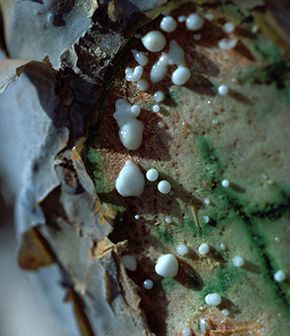
The resin of Frankincense (IMTO archive)
The Frankincense
Frankincense is an aromatic gum resin that is extracted from the
Boswellia sacra tree. An incision is made through the bark, which exudes a white, milky fluid that then dries and hardens in the form of translucent droplets. The tree may grow to a height of seven meters, but only begins producing resin eight or ten years after it has been planted. The branches spring densely from the base of the tree; its leaves are small and fleshy, and the flowers are white. In the past every part of the tree was used – the wood, cut into chips, as a dye; the leaves as forage for animals; and the buds, flowers and fruit to prepare remedies for stomach ailments.
Frankincense in ancient times
Considered the perfume of kings and a symbol of power and wealth and used in places of worship, frankincense has ensured the fortune of southern Arabia since the earliest times. It is mentioned in clay tablets found in Mesopotamia as one of the precious goods originating from the Land of Magan. The frankincense tree is even portrayed in wall paintings in the temple of Queen Hatshepsut (15
th century BC). The queen organized an expedition to the land of frankincense and attempted to introduce the cultivation of the tree in Egypt, but it failed to thrive due to the unsuitable climate. The Greeks first, and then the Romans, used frankincense in large quantities for a variety of purposes. Its fragrance was celebrated in the odes of the classical poets. Sometimes in Rome there was an immoderate use of frankincense; Pliny mentions, for example, that during the funeral of Poppaea, the emperor Nero had an entire year’s imports of the frankincense burned. In ancient times frankincense was burned on official occasions and during religious rites, but it was also used in cosmetics, balms, perfumes, medical remedies, and to preserve food.
Qualities of Frankincense
Four different qualities of frankincense are produced in Oman: the intensely fragrant Al-Hojari harvested in the zone furthest inland during the hottest period of the year; Annajdi, which is produced during the months following the monsoon; Ashazri, which is gathered at the beginning of the rainy season; and the least prized variety, Asha’bi, harvested during the coldest months of the year from trees growing along the coast.
